
Pelham bit
Encyclopedia
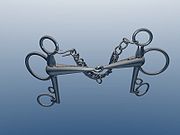
Bit (horse)
A bit is a type of horse tack used in equestrian activities, usually made of metal or a synthetic material, and is placed in the mouth of a horse or other equid and assists a rider in communicating with the animal. It rests on the bars of the mouth in an interdental region where there are no teeth...
used when riding a horse
Horse
The horse is one of two extant subspecies of Equus ferus, or the wild horse. It is a single-hooved mammal belonging to the taxonomic family Equidae. The horse has evolved over the past 45 to 55 million years from a small multi-toed creature into the large, single-toed animal of today...
. It has elements of both a curb bit
Curb bit
A curb bit is a type of bit used for riding horses that uses lever action. It includes the pelham bit and the Weymouth curb along with the traditional "curb bit" used mainly by Western riders....
and a snaffle bit. In this respect a pelham bit functions similar to a double bridle
Double bridle
A double bridle, also called a full bridle or Weymouth bridle, is a bridle that has two bits and four reins . One bit is the bradoon , is a modified snaffle bit that is smaller in diameter and has smaller bit rings than a traditional snaffle, and it is adjusted so that it sits above and behind the...
, and like a double bridle it normally has "double" reins: a set of curb reins and a set of snaffle reins. Because it has a bit shank and can exert curb-style pressure on the horse, it is considered a curb bit. Like all curb bits, a pelham bit has a mouthpiece
Bit mouthpiece
The mouthpiece is the part of a horse's bit that goes into the mouth of a horse, resting on the bars of the mouth in the sensitive interdental space where there are no teeth. The mouthpiece is possibly the most important determinant in the severity and action of the bit. Therefore, it should be...
, shanks with both purchase and lever arms, a ring for rein attachment at the bottom of the shank, and a curb chain
Curb chain
A curb chain, or curb strap, is a piece of horse tack used on any type of curb bit. It is a flat linked chain or strap that runs under the chin groove of the horse, between the bit shank purchase arms. It has a buckle or hook attachment and often has a "fly link" in the middle to apply a lip strap...
. But like a snaffle bit, a pelham bit also has a bit ring
Bit ring
The bit ring is the ring on the side of a horse's bit, particularly on a snaffle bit. It is used as a point of attachment for the cheekpieces of the bridle and for the reins. It also has an effect on the action of the bit...
on either side of the mouthpiece. Like some curb bits, a pelham bit usually has "loose" shanks - hinged at the mouthpiece in the same way that the rings of a snaffle bit are hinged. When two sets of reins are used, the snaffle rein generally is wider, to help distinguish it from the curb. A "cowboy pelham" is a western
Western riding
Western riding is a style of horseback riding which evolved from the ranching and warfare traditions brought to the Americas by the Spanish Conquistadors, and both equipment and riding style evolved to meet the working needs of the cowboy in the American West...
style of loose-jawed curb bit with additional rings at the mouthpiece allowing a second set of reins to be added.
Action
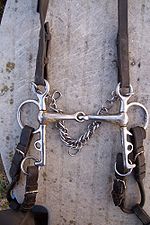
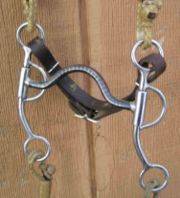
Bit mouthpiece
The mouthpiece is the part of a horse's bit that goes into the mouth of a horse, resting on the bars of the mouth in the sensitive interdental space where there are no teeth. The mouthpiece is possibly the most important determinant in the severity and action of the bit. Therefore, it should be...
of the pelham has a high port or if it is jointed. Pressure on the poll
Poll (horse)
The poll is a name of the part of an animal's head, alternatively referencing a point immediately behind or right between the ears. This area of the anatomy is of particular significance for the horse....
occurs when the curb rein is engaged, and pressure is directly related to the length of the upper shank (purchase arm) in relation to the lower shank (lever arm). All pelhams apply some pressure on the poll. Pressure is applied to the chin groove by the curb chain when the curb rein is used. Direct rein pressure from the snaffle rein may put some pressure on the sides of the horse's mouth, depending on the specific bit design.
Shank
A pelham is a leverLever
In physics, a lever is a rigid object that is used with an appropriate fulcrum or pivot point to either multiply the mechanical force that can be applied to another object or resistance force , or multiply the distance and speed at which the opposite end of the rigid object travels.This leverage...
age bit, meaning that is increases the force but reduces the extent of movement applied by the rider. Unlike a snaffle bit, the curb rein can amplify the rein pressure several times over, depending on the geometry and length of the shank. Shank lengths are 2 inches (5.1 cm) ("Tom Thumb") and longer, although most are less than 4 inches (10.2 cm).
The relation of the purchase arm—the length from the mouthpiece to the cheekpiece rings—and the "shank" or lever arm—the length from the mouthpiece to the lowest rein ring, is important in the severity of the bit. A long lower shank in relation to the upper shank increases the leverage, and thus the pressure, on the curb groove and the bars of the mouth. A long upper shank in relation to the lower shank increases the pressure on the poll, but does not apply as much pressure on the bars of the mouth.
However, longer-shanked bits must rotate back further before applying pressure on the horse's mouth than shorter-shanked bits. Therefore, the horse has more warning in a long-shanked bit, allowing it to respond before any significant pressure is applied to its mouth, than it would in a shorter-shanked bit. In this way, a longer shank can allow better communication between horse and rider, without increasing severity. This is also directly dependent on the tightness of the curb chain.
If the bit has a 1.5" cheek and a 4.5" lower shank, thus producing a 1:3 ratio of cheek to lower shank, while the ratio of the cheek to (upper + lower) shank is 1:4, and producing 4 pounds-force of pressure on the horse's mouth for every 1 pound-force (4 newtons per newton) placed on the reins. If the bit had 2" cheeks and 8" shank (ratio of 1:4), the bit will produce 5 lbf (22.2 N) of tension for every one applied by the reins (5 N/N). Regardless of the ratio, the longer the shank, the less force is needed on the reins to provide a given amount of pressure on the mouth. So, if one were to apply 1 lbf (4.4 N) of pressure on the horse's mouth, a 2" shank would need much more rein pressure than an 8" shank to provide the same effect.
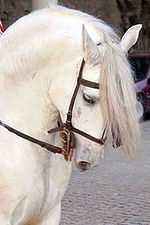
Mouthpiece
As with many other bits, a pelham may have a solid or a jointed mouthpiece. If solid, it may range from a nearly straight "Mullen" mouthpiece up to a medium port. The pelham's mouthpiece controls the pressure on the tongue, roof of the mouth, and bars. A mullen mouth places even pressure on the bars and tongue. A port places more pressure on the bars, and provide room for the tongue. A high port may act on the roof of the mouth as it touches, and will act as a fulcrum, amplifying the pressure on the bars of the mouth.Jointed mouthpieces increase the pressure on the bars as the mouthpiece breaks over in a "nutcracker" effect. Unlike a jointed mouthpiece on a snaffle bit, a jointed mouthpiece on a bit with shanks, such as the pelham, can be quite severe in its effect, particularly if the pressure from the shanks causes the joint of the bit to roll forward and press the tip of the joint into the tongue.
The mouthpiece is placed lower down in a horse's mouth than snaffle bits, usually just touching the corners of the mouth without creating a wrinkle. The lower the bit is placed, the more severe it is as the bars of the mouth get thinner and so pressure is more concentrated.
Curb chain
The curb chainCurb chain
A curb chain, or curb strap, is a piece of horse tack used on any type of curb bit. It is a flat linked chain or strap that runs under the chin groove of the horse, between the bit shank purchase arms. It has a buckle or hook attachment and often has a "fly link" in the middle to apply a lip strap...
applies pressure to the groove under a horse's chin. It amplifies the pressure on the bars of the horse's mouth, because when it tightens it acts as a fulcrum.
Adjusted correctly, the chain links lie flat and hang loose below the chin groove, coming into action against the jaw only when the shanks have rotated due to rein pressure. The point at which the curb chain engages varies with the individual needs of the horse, but contact at 45 degrees of shank rotation is a common default adjustment.
Uses

English riding
English riding is a term used to describe a form of horse riding that is seen throughout the world. There are many variations in English riding, but all feature a flat English saddle without the deep seat, high cantle or saddle horn seen on a Western saddle nor the knee pads seen on an Australian...
disciplines, it is used in place of a double bridle, when it is desirable to have double reins but not two bits. The pelham bit is also used for polo
Polo
Polo is a team sport played on horseback in which the objective is to score goals against an opposing team. Sometimes called, "The Sport of Kings", it was highly popularized by the British. Players score by driving a small white plastic or wooden ball into the opposing team's goal using a...
, when the action of a double bridle is desired, but the rider's ability to make rein adjustments is limited.In training, a pelham bit sometimes is used in both English and western disciplines to transition a horse from a snaffle bit to a curb bit or double bridle.
Sometimes, a bit converter
Bit converter
A bit converter, also known as a pelham rounding, is used on pelham bits to change them from two-rein bits to one-rein bits. It is a leather strap that attaches from the snaffle ring to the curb ring, onto which the rein is then attached to the loop made between the two rings...
, also known as a pelham rounding, is used so a pelham can be used with one pair of reins. This is most often seen with beginners and for riders in the cross-country phase of eventing
Eventing
Eventing is an equestrian event comprising dressage, cross-country, and show jumping. This event has its roots in a comprehensive cavalry test requiring mastery of several types of riding...
. However, use of a converter is illegal in most other horse show
Horse show
A Horse show is a judged exhibition of horses and ponies. Many different horse breeds and equestrian disciplines hold competitions worldwide, from local to the international levels. Most horse shows run from one to three days, sometimes longer for major, all-breed events or national and...
classes.
Horse shows
In horse showHorse show
A Horse show is a judged exhibition of horses and ponies. Many different horse breeds and equestrian disciplines hold competitions worldwide, from local to the international levels. Most horse shows run from one to three days, sometimes longer for major, all-breed events or national and...
s, a pelham bit may be used in some disciplines but is prohibited in others. In the United States
United States
The United States of America is a federal constitutional republic comprising fifty states and a federal district...
, use of a pelham bit is prevalent in hunt seat
Hunt seat
Hunt seat is terminology used in the United States and Canada to refer to a style of forward seat riding commonly found at American horse shows. Along with Dressage, it is one of the two classic forms of English riding. The Hunt seat is based on the tradition of fox hunting...
equitation
Equitation
Equitation is the art or practice of horse riding or horsemanship.More specifically, equitation may refer to a rider's position while mounted, and encompass a rider's ability to ride correctly and with effective aids. In horse show competition, the rider, rather than the horse is evaluated...
, and occasionally in show jumping
Show jumping
Show jumping, also known as "stadium jumping," "open jumping," or "jumpers," is a member of a family of English riding equestrian events that also includes dressage, eventing, hunters, and equitation. Jumping classes commonly are seen at horse shows throughout the world, including the Olympics...
and eventing
Eventing
Eventing is an equestrian event comprising dressage, cross-country, and show jumping. This event has its roots in a comprehensive cavalry test requiring mastery of several types of riding...
. Use of this bit is legal, but not common, in show hunter
Show hunter
The show hunter is a type of show horse that is judged on its movement, manners, and way of going, particularly while jumping fences. The horses are shown in hunt seat style tack, and are often of Warmblood or Thoroughbred type, though a hunter-style pony is also seen in youth classes...
, and English pleasure
English Pleasure
English pleasure is generic term for a number of different English riding classes seen at horse shows in the United States, where the horse is ridden in either hunt seat or saddle seat tack....
. In the United Kingdom
United Kingdom
The United Kingdom of Great Britain and Northern IrelandIn the United Kingdom and Dependencies, other languages have been officially recognised as legitimate autochthonous languages under the European Charter for Regional or Minority Languages...
, this bit is often used in place of a double bridle
Double bridle
A double bridle, also called a full bridle or Weymouth bridle, is a bridle that has two bits and four reins . One bit is the bradoon , is a modified snaffle bit that is smaller in diameter and has smaller bit rings than a traditional snaffle, and it is adjusted so that it sits above and behind the...
in show hunter
Show hunter (British)
The show hunter is a type of show horse commonly seen at equestrian events across Britain. The British "show hunter" is shown primarily on the flat, while the "working hunter" must also jump a series of rustic fences .The governing body that oversees show hunter horses is Sport Horse Breeding ,...
, show hack
Show hack
The show hack is a type of ridden show horse, exhibited to a standard first established in England.Affiliated showing and breeding of the show hacks in the United Kingdom is overseen by the British Show Horse Association....
, Riding Horse
Riding Horse
The Riding Horse is a type of show horse in the UK. Riding horses can be any breed, but are generally warmbloods or Thoroughbred crosses.The breeding and showing of riding horses is overseen by the British Show Horse Association.-Showing the riding horse:...
, show cob
Cob (horse)
A cob is a small horse, usually of a stout build, with strong bones, large joints, and steady disposition; it is a body type of horse rather than a specific breed...
and mountain and moorland
Mountain and moorland
Mountain and moorland or M&M ponies form a group of several breeds of ponies and small horses native to the British Isles. Many of these breeds are derived from semi-feral ponies kept on moorland or heathland, and some of them still live in this way, as well as being kept as fully domesticated...
classes, but it is forbidden in equitation and novice classes. The pelham is not permitted in dressage
Dressage
Dressage is a competitive equestrian sport, defined by the International Equestrian Federation as "the highest expression of horse training." Competitions are held at all levels from amateur to the World Equestrian Games...
at any level. The pelham is never legal for use in any western riding
Western riding
Western riding is a style of horseback riding which evolved from the ranching and warfare traditions brought to the Americas by the Spanish Conquistadors, and both equipment and riding style evolved to meet the working needs of the cowboy in the American West...
discipline, where either a snaffle bit or a curb bit
Curb bit
A curb bit is a type of bit used for riding horses that uses lever action. It includes the pelham bit and the Weymouth curb along with the traditional "curb bit" used mainly by Western riders....
is used.
Driving
Variations of the pelham bit are often seen in drivingDriving (horse)
Driving, when applied to horses, ponies, mules, or donkeys, is a broad term for hitching equines to a wagon, carriage, cart, sleigh, or other horse-drawn vehicle by means of a harness and working them in this way...
in situations where a bit more control is required that can be obtained with a snaffle alone or with a combination of snaffle and overcheck. Shank designs and size are governed by the rules for various forms of competition and very considerably across disciplines from combined driving
Combined driving
Combined driving also known as Horse Driving Trials is an equestrian sport involving carriage driving. In this discipline the driver sits on a vehicle drawn by a single horse, a pair or a team of four. The sport has three phases: Dressage, Cross-country Marathon and Obstacle Cone Driving and is...
to draft horse showing
Draft horse showing
Draft horse showing refers to horse shows exclusively for horses of the draft horse breeds. In North America, though a small number of draft horses are also shown under saddle, the term "Draft horse showing" refers to a specific horse show competition that primarily features driving exhibitors...
.
Polo
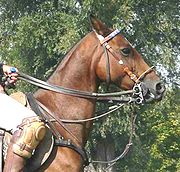
Polo
Polo is a team sport played on horseback in which the objective is to score goals against an opposing team. Sometimes called, "The Sport of Kings", it was highly popularized by the British. Players score by driving a small white plastic or wooden ball into the opposing team's goal using a...
, a pelham bit is one of the two bits most commonly used (the other being a gag bit
Gag bit
The gag bit is a type of bit for a horse. With two sets of reins, the gag bit gives a rider the ability to use either a standard direct action or a gag action. In this, the gag bit is related to a Pelham bit and a double bridle...
). Double reins are held in one hand. Neck rein
Neck rein
A neck rein is a type of indirect rein aid. The horse responds to a neck rein when it has learned that a light pressure of the right rein against its neck on that side means for the horse to turn left, and vice versa....
ing is used almost exclusively, and riders have little or no need to adjust the reins while riding. Draw reins are commonly used, on the snaffle ring. The rein lengths are adjusted so that the rein used normally is the snaffle rein, with the curb rein only coming into effect when needed. Such techniques are not legal in show disciplines and are exclusive to polo.
History

Cavalry
Cavalry or horsemen were soldiers or warriors who fought mounted on horseback. Cavalry were historically the third oldest and the most mobile of the combat arms...
units as it was designed to suit as many horses' mouths as possible. The Australian design had one side of the mouthpiece smooth and the other serrated. Various rein attachments were also possible with this bit.

